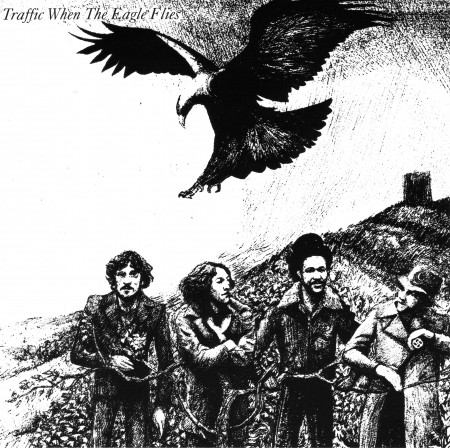
When The Eagle Flies: Liner Notes
Traffic: When The Eagle Flies
(Originally Released September 1, 1974)
Liner Notes by Bill DeYoung
Released in the fall of 1974, When the Eagle Flies was Traffic's swan song. Since the band's humble beginnings, Steve Winwood had taken Traffic's music through a half-dozen radical permutations, leading with evolutionary zeal to the spacey and wide-open frontiers of The Low Spark of High Heeled Boys and Shoot Out at the Fantasy Factory. By '73's On the Road, Traffic had become a seven-member band, ministering R&B, jazz and rock 'n' roll to sold-out audiences around the world.
For When the Eagle Flies, the key word was simplification.
Winwood agreed with Rolling Stone's suggestion that the album was something of a return to Traffic's roots.
"But we're not trying to become a parody of ourselves," he insisted in a 1974 profile of the band. "We're trying to realize how we do things best. Things are a bit more flexible now, obviously ...the music has evolved, not digressed."
For Winwood, flexibility meant saying goodbye to Muscle Shoals players Roger Hawkins, David Hood and Barry Beckett-and longtime percussionist Reebop Kwaku Baah.
Winwood, Jim Capaldi and Chris Wood recruited Jamaican-born bassist Rosko Gee, who'd played in the British reggae band Gonzales, and holed up at Winwood's country estate. Most of When the Eagle Flies was cut on an eight-track machine at the Traffic director's studio, Netherturkdonic. Several of the basic tracks were recorded live in the U.K., on a short tour that preceded the studio sessions. These were then overdubbed at Netherturkdonic.
As always, the bulk of the material was written by Winwood (music) and Capaldi (lyrics). The exception was the playful "Dream Gerrard," with music by Winwood and words by former Bonzo Dog Doo Dah Band frontman Vivian Stanshall, on whose recent solo album Winwood had guest-appeared. (Stanshall would co-write several songs with Winwood, including "Arc of a Diver," the title track to Winwood's breakthrough solo set in 1981.)
"Dream Gerrard," a mini-suite layered with soulful Winwood vocals, a catchy, syncopated riff from Wood's saxophone and a synthesized string section, is the album's most ambitious number. On the evocative "Graveyard People" Winwood handles both electric piano and syntheizer. The master musician also plays acoustic piano, mellotron, organ and all the guitars on the album.
Capaldi is heard on percussion, and in the drummer's chair for the first time since John Barleycorn Must Die. Gee lays down a popping funk riff for "Walking in the Wind," with tasty sax riffs from Wood and one of Winwood's magnificent solos on the Hammond organ.
The simple "Memories of a Rock 'N Rolla" finds Winwood musing on his own transition from young, green musician ("Playing music for the people seemed to be enough") to rock star ("Dressed in sparkling colored clothes"). Wood takes the solos on his flute for the hypnotic "Love," recorded live on the road.
The closer, "When the Eagle Flies," is a soulful, piano-based piece about the perils of ecological imbalance. "Do you hear me, Mother Nature?" Winwood cries as the album fades.
When the Eagle Flies was the most organic Traffic album of the 1970s. "Our attitude has changed back to the way it was when we were making the first two Traffic albums," enthused Wood to Rolling Stone. "We, or at least I, haven't really been satisfied with any since then, except perhaps John Barleycorn. There's more of a personal expression in When the Eagle Flies that represents a progression."
In the end, they were well aware of "what they did best." When the Eagle Flies stands as testament to the relentlessly creative art that Winwood, Capaldi and Wood made together. It's a fitting finale to a brilliant journey.